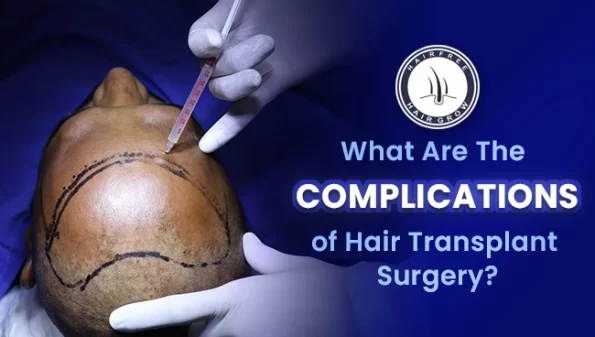Hair transplant surgery is an increasingly popular cosmetic procedure that can help restore hair growth in balding areas. While it can be a life-changing experience for many individuals, it is not without its risks. The question is, what are the complications of hair transplant surgery? Are they worth the risk?
In short, the answer is yes, but only if you do your research and choose a qualified and experienced surgeon. Complications of hair transplant surgery can include infection, bleeding, swelling, scarring, and even hair loss. However, these risks can be minimized by taking proper care before and after the procedure and following your surgeon’s instructions closely.
If you’re considering hair transplant surgery, it’s essential to understand the potential complications and take steps to minimize them.
Probable Complications of Hair Transplant Surgery
Hair transplant surgery is a popular procedure for people who are experiencing hair loss. While it is generally considered safe and effective, patients should be aware of some potential side effects and complications.
Swelling
Swelling is a common side effect that can occur after hair transplant surgery. This is usually temporary and can be managed with ice packs and pain medication. However, excessive swelling can occur in some cases, which may require medical attention.
Advantage at hairfree hairgrow clinic:
- Modified our anesthesia solutions and way of injecting them leads to least bulge or swelling post procedure.
- Modification in post procedure medications which controls the inflammatory process and avoid further adding to volume of swelling
Bleeding
Bleeding is another potential complication of hair transplant surgery. This can occur around the stitches in the donor area or if a graft becomes dislodged. Persistent bleeding should be reported to the clinic immediately.
Advantage at hairfree & hairgrow clinic:
- Use cold saline anesthesia for to reduce bleeding rate at it leads to temporary reduction in blood flow to anesthetized area.
- We use sharp serrated micro punches for graft collection leads to tiny holes which heals faster.
- Sapphire tip blade used for slit making to reduce trauma to implant area skin and better healing.
- Premedication with tranexamic acid tablet to reduce bleeding and complications.
- Use of blunt implanter to insert grafts into skin leads to least tissue and graft manipulation
Pain
Pain and discomfort are also common after hair transplant surgery, but these can usually be managed with pain medication. Numbness is also normal and may last for several weeks.
Advantage at hairfree & hairgrow clinic:
- Use of advance modified block type local anesthesia which gives long lasting numbness effect so patient procedure is smooth and painless once anesthesia given.
- Use of micro needles (world’s smallest possible) to reduce pain while injecting anesthesia solution.
- Use of vibration device to divert and reduce pain sensation.
- Use of buffer agents in anesthesia solution to reduce burning and stinging sensation while injecting the anesthesia into the skin.
Infection
Infection is a rare but serious complication that can occur after hair transplant surgery. Patients should be vigilant for signs of infection, such as redness, tenderness, and pain. If these symptoms occur, medical attention should be sought immediately.
Advantage at hairgree hairgrow clinic:
- Strick operation theater protocol being used.
- Autoclave process to sterilize instruments being done before each procedure.
- Fumigation process to sterilize operation theater room before each procedure.
- Safety and hygiene maintained by well trained and skilled hair transplant teams.
- Dedicated separate procedure room meant for hair transplant only.
- Proper antibiotic coverage given to each patient from the day of procedure for 1 week.
Thinning
Thinning of pre-existing hair is another potential side effect of hair transplant surgery. This is usually temporary and will resolve on its own within a few months. To avoid such problem we use sapphire tip blade for slit making which helps to avoid any damage to existing hair follicles in the implant area zone
We also take care of donor area existing hairs by using micro sharp serrated punches to avoid damage.
Itching
Itching is another common side effect of hair transplantation. This is usually mild and only lasts a few days. Patients can help alleviate this discomfort by spraying the affected area in the initial days after surgery and shampooing their hair daily.
Special tablet given post procedure to control the itch sensation.
Keloid
Keloid scarring is a rare but possible complication of hair transplantation. This is an abnormal scar that grows beyond the boundary of the original site of a skin injury. It is more likely to occur in pre-disposed individuals and can cause a raised, ill-defined growth of skin in the area of damaged skin. In rare cases, keloid scarring can cause a ridging effect. Patients should discuss their risk of keloid scarring with their surgeon before undergoing hair transplantation.
In such cases before doing a full procedure we do one small trial session of 100-300 grafts and wait for 3-6 months to see if there is any abnormal healing pattern, this way we have done the majority of hair transplant procedures in all keloid tendency patients.
Cysts
Cysts may also develop after hair transplantation, especially when many grafts have been transplanted. These cysts are usually no more than 2 or 3mm in diameter and are similar in size to small pimples. They typically disappear on their own after a few weeks and can be effectively treated if necessary.
How to Minimize Hair Transplant Side Effects
While some side effects of hair transplant surgery are unavoidable, there are steps you can take to minimize them. These include:
Following Your Surgeon's Instructions
Your surgeon will provide you with specific instructions on how to care for your scalp after undergoing hair transplant surgery. It is important to follow these instructions carefully to minimize the risk of complications.
Avoiding Strenuous Activities
You should avoid strenuous activities, such as exercise or heavy lifting, for at least a few days after undergoing hair transplant surgery. This can help to reduce swelling and discomfort.
Sleeping with Your Head Elevated
Sleeping with your head elevated can help to reduce swelling after undergoing hair transplant surgery. You may want to prop yourself up with pillows or sleep in a recliner for the first few nights after the procedure.
Conclusion
Hair transplant surgery can effectively treat male pattern baldness, but it is important to understand the potential side effects before undergoing the procedure. Following your surgeon’s instructions and taking steps to minimize side effects can increase your chances of a successful outcome. Contact your surgeon immediately if you experience any unusual symptoms after undergoing hair transplant surgery. Still confused, then you can contact the Hairfree Hairgrow clinic today for full information about Hair Transplant Surgery.
Written By
MBBS, DVD (Skin & VD)
Dr Ankit Jain is Hair Transplant Surgeon at Hairfree & Hairgrow Clinic Bhopal Center Since 2019. He is expert in dealing with complications that may arise after hair transplants.
Disclaimer
We’ve made all possible efforts to ensure that the information provided here is accurate, up-to-date and complete, however, it should not be treated as a substitute for professional medical advice, diagnosis or treatment. See Detailed Disclaimers Here.


